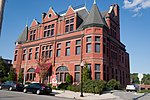Stone Hill Historic District
Baltimore Registered Historic Place stubsGeorgian architecture in MarylandHistoric districts on the National Register of Historic Places in BaltimoreNRHP infobox with nocat

Stone Hill Historic District is a national historic district in Baltimore, Maryland, United States. It is one of the original mill villages along the Jones Falls, having been developed circa 1845–1847 to house textile mill workers. Comprising seven blocks, the district includes 21 granite duplexes, a granite Superintendent's House, and a granite service building (now converted to a duplex) – all owned by Mount Vernon Mills from 1845 to 1925.It was added to the National Register of Historic Places in 2001.
Excerpt from the Wikipedia article Stone Hill Historic District (License: CC BY-SA 3.0, Authors, Images).Stone Hill Historic District
Puritan Street, Baltimore
Geographical coordinates (GPS) Address Nearby Places Show on map
Geographical coordinates (GPS)
| Latitude | Longitude |
|---|---|
| N 39.323333333333 ° | E -76.629444444444 ° |
Address
Puritan Street 730
21211 Baltimore
Maryland, United States
Open on Google Maps








